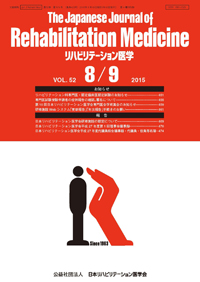All issues

Predecessor
Volume 52, Issue 8-9
Displaying 1-6 of 6 articles from this issue
- |<
- <
- 1
- >
- >|
Editorials
-
[in Japanese]2015 Volume 52 Issue 8-9 Pages 518-521
Published: 2015
Released on J-STAGE: August 29, 2015
JOURNAL FREE ACCESSDownload PDF (2670K)
51st Annual Meeting of the Japanese Association of Rehabilitation Medicine Panel Discussion
-
2015 Volume 52 Issue 8-9 Pages 522-541
Published: 2015
Released on J-STAGE: August 29, 2015
JOURNAL FREE ACCESS
Rehabilitation Model in a Community ; What Physiatrist can Show and Manage?…Kazuyo OGUCHI 522
The Only Convalescence Rehabilitation Ward alone Hospital Managed by a Local Government directly in Japan and Resident Education…Kazuto AKABOSHI 526
Form of our Recovery Phase Rehabilitation Ward : As a Branch Hospital of Kagoshima University Hospital…Atsuko OGATA 529
Training Rehabilitation Doctors in a Kaifukuki Rehabilitation Ward…Hidekazu SUGAWARA 533
The Appropriate Way of the Medical Doctor in Recovery Rehabilitation : A Personal Opinion…Ataru FUKUDA, Isao KITAHARA, Yoshinori TESHIMA, Tomohiro MORITO, Ryou TANAKA, Takashi SOTA 537View full abstractDownload PDF (2430K) -
2015 Volume 52 Issue 8-9 Pages 542-549
Published: 2015
Released on J-STAGE: August 29, 2015
JOURNAL FREE ACCESS
Rehabilitation for TBI on Sub-acute Phase : Cognitive Problems as Obstacles to Social Participation…Minoru TOYOKURA 542
Rehabilitation of Traumatic Head Injured Patients in the Chronic Life Stage…Mitsuo TAKEI 547View full abstractDownload PDF (960K)
Short Note
-
Yasuhiro Ono, Toru Honda, Hiroshi Kuwajima, Maki Komobuchi, Kouhei Yam ...2015 Volume 52 Issue 8-9 Pages 550-554
Published: 2015
Released on J-STAGE: August 29, 2015
JOURNAL FREE ACCESSObjective : Serum albumin is important marker in all aspects of stroke care including rehabilitation. We examined the serum albumin level of stroke patients, and investigated the relation between their serum albumin level and their prognosis. Methods : The serum albumin levels of 295 patients enrolled from 2008 to 2014 were sequentially checked in our hospital and in subsequent rehabilitation hospitals. Functional outcome was measured by functional independence measure (FIM) at the time of discharge from the rehabilitation hospital. Results : In all types (cerebral infarction, cerebral hemorrhage and subarachnoid hemorrhage (SAH)) of apoplexy, serum albumin levels were the highest at the time of admission, temporarily declined after admission, and almost recovered at the time of discharge. In SAH, the serum albumin levels deteriorated at a greater rate than in other types of stroke. In cerebral infarction and cerebral hemorrhage, the lowest serum albumin level was positively correlated with FIM at the time of discharge from the rehabilitation hospital (p<0.001). But, in SAH, there was no significant correlation between the lowest serum albumin level and FIM at the time of discharge (p=0.844). Conclusion : Our data suggest that serum albumin level is associated with the outcome of stroke patients, except for SAH patients. Serum albumin level should be one of the prognostic factors used in stroke patients, but we should consider that SAH patients are exceptional because of other neurological complications.View full abstractDownload PDF (599K)
Case Report
-
Satoshi TAMAI, Yumiko IMAI, Hitomi YANAGISAWA, Yuko SATO, Keiji HASHIM ...2015 Volume 52 Issue 8-9 Pages 555-561
Published: 2015
Released on J-STAGE: August 29, 2015
JOURNAL FREE ACCESSA sixteen-year-old girl with neuropsychological dysfunction after cerebral encephalopathy came to our hospital for evaluation of her cognitive impairment and ability to acquire compensatory skills for communicative dysfunction. Neuropsychological examinations revealed low scores on FSIQ, VCI, WMI and PSI by WISC-Ⅳ. We intervened using a process-orientated speech-language-hearing therapy to improve her cognitive, language and communicative skills for a year. After that, we evaluated her cognitive ability by WISC-Ⅳ and LCSA. As a result of our intervention, her word knowledge, idiom and mental expression, sentence expression and reading social condition and expression scores in LCSA performance were improved but each IQ by WISC-Ⅳ was preserved. In ST intervention for pediatric neuropsychological dysfunction, the patient evaluation should be made not only using IQ by WISC-IV but also by measuring other communicative skills such as by LCSA.View full abstractDownload PDF (767K)
Regional Meetings
-
2015 Volume 52 Issue 8-9 Pages 562-569
Published: 2015
Released on J-STAGE: August 29, 2015
JOURNAL FREE ACCESSDownload PDF (725K)
- |<
- <
- 1
- >
- >|